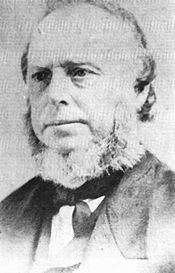Role Latter Day Saints Name William Law | Parents Richard LawAnn Hunter Spouse(s) Jane Silverthorn | |
 | ||
Resting place Evergreen Cemetery42°34′07″N 90°13′44″W / 42.5686°N 90.2289°W / 42.5686; -90.2289 (Evergreen Cemetery) Died January 19, 1892, Shullsburg, Wisconsin, United States | ||
The ancient paths grant palmer william law leaves joseph smith
William Law (September 8, 1809 – January 19, 1892) was an important figure in the early history of the Latter Day Saint movement, holding a position in the early church's First Presidency under Joseph Smith. Law was later excommunicated from the church and was the founder of the short-lived True Church of Jesus Christ of Latter Day Saints. In this capacity, he published a single edition of the Nauvoo Expositor, the destruction of which set in motion a chain of events that eventually led to Smith's assassination.
Contents
- The ancient paths grant palmer william law leaves joseph smith
- William law attacks joseph smith unlocking the mystery of the two prophets revelation 11
- Biography
- References
William law attacks joseph smith unlocking the mystery of the two prophets revelation 11
Biography
Law was born in County Tyrone, Ireland, to Richard Law and Ann Hunter as the youngest of five children. His older brother was Wilson Law. The Law family moved to the United States around 1820, and he eventually ended up in Upper Canada. At the age of 24 he married Jane Silverthorn, who was 19 years old.
Law and his wife joined the Church of the Latter Day Saints in 1836, through the efforts of John Taylor and Almon W. Babbitt. He led a group of Canadian saints to Nauvoo, Illinois, in 1839 and in 1841, Joseph Smith chose him to be a member of the First Presidency.
As time progressed, Law became troubled by certain practices of Smith. He felt the prophet was uniting church and state in Nauvoo, Illinois, by evading extradition to be tried for crimes in Missouri. He also thought Smith used his church authority to sway political outcomes. However, it was Smith's covert practice of polygamy that caused Law to completely separate himself. Rumors circulated that Smith had made several proposals to Law's wife Jane, under the premise that Jane Law would enter a polyandrous marriage with Smith. Law and his wife confirmed that these rumors were true. However, according to Alexander Neibaur, he was told a rumor that Jane Law had actually asked to be sealed to Smith after Smith had refused to seal her to her husband. According to the rumor, Smith had denied the couple because he thought William Law was guilty of adultery, though he did not tell Jane Law his reasons. However, years later, according to Ann Eliza Young (wife #19 to Brigham Young), Jane claimed that Smith visited her at night when he knew William would not be home and propositioned her, suggesting to her that it was God's will that she enter into a polyandrous marriage with Smith. Young's account states that Jane Law described Smith's proposals, saying that Smith had "asked her to give him half her love; she was at liberty to keep the other half for her husband." She refused Smith's request to marry him as a polyandrous plural wife. Law still believed Mormonism to be true, but he viewed Smith as a fallen prophet.
On January 8, 1844, Law was informed that he was no longer a counselor to Smith in the First Presidency. He was shocked and frustrated. He demanded a rehearing of his case, because the procedures for removal from the First Presidency had not been followed. The rehearing was granted and on April 18, 1844, he was tried again. However, this time he was tried as if he were a private member and not a high-ranking church official. Once again he felt this went against church protocol. The following day he was informed of his excommunication on grounds of apostasy. At this point, he felt Smith was beyond saving, and that it was his duty to expose him to the rest of the Mormon community.
Law met privately after his excommunication with other opponents of Smith and formed a group. After they were joined by two boys, Dennison L. Harris and Robert Scott, they were exposed after these boys reported their plans to Smith. Shortly thereafter, Law created the True Church of Jesus Christ of Latter Day Saints and became its President. On June 7, 1844, Law and his followers published the Nauvoo Expositor, a newspaper that outlined Law's contentions against Smith, including the then-secret practice of plural marriage. The reaction to the newspaper was not what Law expected, and after two days of consultation, the printing press was ordered destroyed by Smith and the Nauvoo city council. It was destroyed later that day.
Smith was later arrested and taken to nearby Carthage, Illinois, on charges relating to the destruction of the Expositor. On June 27, 1844, Smith was killed by a mob.
For many years, Law was accused of being a member or a leader of the mob that killed Smith. However, Law's diary shows that he was not in Carthage at the time of the murder, though he had been present there earlier in the day. Although Law expresses outrage and remorse at Smith's death in his private journal, he goes on to say that it was Smith's goal "to demoralize the world, to give it to Satan, his master..... He claimed to be a god, whereas he was only a servant of the Devil, and as such he met his fate."
In 1887, Law agreed to be interviewed reflecting on his experience with Mormonism. This interview, along with three letters by Law, were published in the Salt Lake Tribune.
Law eventually moved to Shullsburg, Lafayette County, Wisconsin, where he died in 1892.
